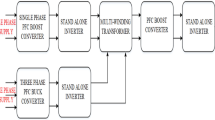Abstract
A vector oriented control technique with a two-loop control scheme has been developed for operating a stand-alone three-phase SEIG for supplying DC loads through a three-phase Pulse Width Modulated (PWM) rectifier. The proposed controller maintains constant load voltage with reduced harmonics at the PWM rectifier input terminals. In addition, it controls the real and reactive power flow between the SEIG and converter system. The proposed control scheme has been implemented employing dSPACE 1103 real-time controller. The successful working of the proposed control strategy has been verified for different operating conditions, by modelling the system in MATLAB/Simulink toolbox and the results are presented. A prototype system consisting of an SEIG, PWM rectifier and associated control circuits, has been built in the laboratory environment and a close agreement between the simulated and experimental results has been confirmed.






Similar content being viewed by others
References
H. Li, Z. Chen, Overview of different wind generator systems and their comparisons. IET Renew. Power Gener. 2(2), 123–128 (2008)
R.C. Bansal, T.S. Bhatti, D.P. Kothari, Bibliography on the application of induction generators in nonconventional energy systems. IEEE Trans. Energy Convers. 18(3), 433–439 (2003)
G.K. Singh, Self-excited induction generator research—a survey. Electric Power Syst. Res. 69, 107–114 (2004)
S. Dudhani, A.K. Sinha, S.S. Inamdar, Renewable energy sources for peak load demand management in India. Int. J. Electr. Power Energy Syst. 28(6), 396–400 (2006)
S. Senthil Kumar, N. Kumaresan, N. Ammasai Gounden, N. Rakesh, Analysis and control of wind-driven self-excited induction generators connected to the grid through power converters. Front. Energy 6(4), 403–412 (2012)
B. Singh, S.S. Murthy, S. Gupta, Analysis and design of electronic load controller for self-excited induction generators. IEEE Trans. Energy Convers. 21(1), 285–293 (2006)
N. Rakesh, N. Kumaresan, S. Senthil Kumar, M. Subbiah, Major methods of steady-state analysis of three-phase SEIGs-A summary, in Proceedings of the 3rd IEEE International Conference on Sustainable Energy Technologies (IEEE ICSET 2012), September 2012, Kathmandu, Nepal, pp. 415–419
N. Kumaresan, M.P. Selvan, M. Subbiah, Design optimisation and speed extension of wind-driven self-excited induction generators—a new approach. Electr. Power Compon. Syst. 32(2), 215–228 (2004)
S. Hazra, P.S. Sensarma, Vector approach for self-excitation and control of induction machine in stand-alone wind power generation. IET Renew. Power Gener. 5(5), 397–405 (2011)
S. Hazra, P.S. Sensarma, Self-excitation and control of an induction generator in a stand-alone wind energy conversion system. IET Renew. Power Gener. 4(4), 383–393 (2010)
T. Ahmed, K. Nishida, M. Nakaoka, Advanced control for PWM converter and variable-speed induction generator. IET Electr. Power Appl. 1(2), 239–247 (2007)
M.A. Abdel-Halim, A.F. Almarshoud, A.I. Alolah, Performance of grid connected induction generator under naturally commutated AC voltage controller. Electr. Power Compon. Syst. 32(7), 691–700 (2004)
G.V. Jayaramaiah, B.G. Femandes, Analysis of voltage regulator for 3-Φ self-excited induction generator using current controlled voltage source inverter, in IEEE International Conference on TENCON, vol 3, no. 1 (2004), pp. 1404–1408
G.V. Jayaramaiah, B.G. Femandes, Voltage controller for stand-alone induction generator using instantaneous power control, in IEEE First International Conference on Power Electronics Systems and Applications, vol 1, no. 1 (2004), pp. 102–106
S.C. Kuo, L. Wang, Analysis of voltage control for self-excited induction generator using a current controlled voltage source inverter (CC-VSI). IEEE Proc. Gener. Trans. Distrib. 148(5), 431–438 (2001)
R. Karthigaivel, N. Kumaresan, M. Subbiah, Analysis and control of self-excited induction generator-converter systems for battery charging applications. IET Electr. Power Appl. 5(2), 247–257 (2011)
S. Senthil Kumar, N. Kumaresan, M. Subbiah, Modelling, analysis and control of standalone self-excited induction generator-pulse width modulation rectifier systems feeding constant DC voltage applications. IET Gener. Transm. Distrib. 8(6), 115–1140 (2014)
N. Kumaresan, Analysis and control of three-phase self-excited induction generators supplying single-phase AC and DC loads. IEE Proc. Electr. Power Appl. 152(3), 739–747 (2005)
B. Singh, S.S. Murthy, S. Gupta, Analysis and design of STATCOM-based voltage regulator for self-excited induction generators. IEEE Trans. Energy Convers. 19(4), 783–790 (2004)
S. Senthil Kumar, N. Kumaresan, N. Rakesh, K. Vijayakumar, M. Subbiah, Wind-driven SEIGs for supplying isolated loads employing DSP based power electronic controllers. Int. J. Wind Eng. 36(6), 739–758 (2012)
P.C. Krause, O. Wasynczuk, S.D. Sudhoff, Analysis of Electric Machinery and Drive Systems, 3rd edn. (IEEE Press, New Jersey, 2013)
M.A. Abdel Halim, Solid state control of grid connected induction generator. Electr. Power Compon. Syst. 29(1), 163–178 (2001)
N. Ammasaigounden, M. Subbiah, Microprocessor-based voltage controller for wind-driven induction generators. IEEE Trans. Ind. Electron. 37(6), 531–537 (1990)
N. Ammasaigounden, M. Subbiah, M.R. Krishnamurthy, Wind-driven self-excited pole-changing induction generator. IEEE Proc. B 133(5), 315–321 (1986)
Acknowledgements
The authors gratefully acknowledge the authorities of the National Institute of Technology, Tiruchirappalli, India for all the facilities provided for carrying out the experimental work in the preparation of this paper. Further, this work was supported in part by the National Institute of Wind Energy (Formerly Centre for Wind Energy Technology), Chennai, India, an autonomous Research and Development Institution under the Ministry of New and Renewable Energy, Govt. of India.
Author information
Authors and Affiliations
Corresponding author
Appendix
Appendix
The instantaneous real power at SEIG terminals is given by:
where \(i_{Ra} ,i_{Rb} ,i_{Rc}\) are the instantaneous rectifier input currents. The steady-state modelling of the system can be represented as
where x is instantaneous voltage and currents.
By using above abc to dq transformation matrix, Eq. (2) can be modified as follows,
Further, the equations can be modified as
where,
By using abc to dq transformation matrix Eq. (5) can be modified as:
Rights and permissions
About this article
Cite this article
Akbarali, M.S., Subramanium, S.K. & Natarajan, K. Real and Reactive Power Control of SEIG Systems for Supplying Isolated DC Loads. J. Inst. Eng. India Ser. B 99, 587–595 (2018). https://doi.org/10.1007/s40031-018-0350-8
Received:
Accepted:
Published:
Issue Date:
DOI: https://doi.org/10.1007/s40031-018-0350-8




